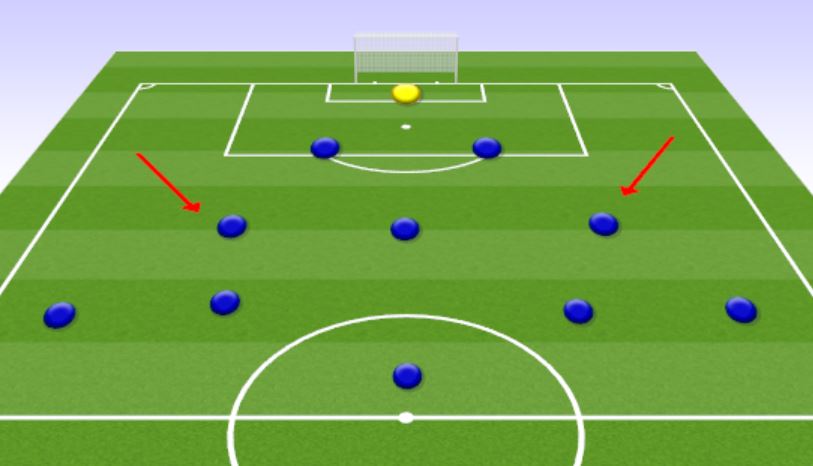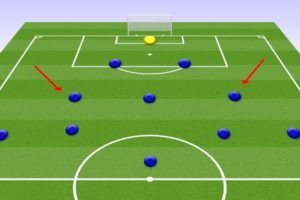Inverted Fullback Position: A Tactical Analysis for Modern Football Teams
The inverted fullback is a relatively new position in football that has gained popularity in recent years. This position requires a player to play as a fullback but with a twist. Instead of staying wide and providing crosses, the inverted fullback moves inside and plays more like a central midfielder. This position has been popularized by coaches such as Pep Guardiola and Jurgen Klopp, who have used it to great effect in their respective teams.
One of the main advantages of the inverted fullback position is that it allows teams to overload the midfield. By moving the fullback inside, the team can create a numerical advantage in midfield, which can help them dominate possession and control the game. The inverted fullback can also help to create passing triangles and provide an extra passing option for the midfielders.
However, playing as an inverted fullback requires a high level of technical ability and tactical intelligence. The player needs to be comfortable on the ball, have good passing ability, and be able to read the game well. They also need to be disciplined defensively and be able to track back and defend when needed. Overall, the inverted fullback is an exciting new position in football that has the potential to revolutionize the game.
What is an Inverted Fullback Position?
An inverted fullback is a player who plays in the fullback position but has a tendency to move centrally into midfield areas during the build-up and progression phases of the game. This player role has become increasingly popular in modern football due to its tactical flexibility and ability to create overloads in midfield.

The inverted fullback is often used when the team’s wingers like to cut inside, as it allows the fullback to move centrally and slot themselves as the third midfielder, creating numerical superiority in midfield. This player can also overlap the wingers when necessary, providing an additional attacking option in the final third.
The role of the inverted fullback requires a high level of tactical awareness and technical ability. The player must be able to read the game and make quick decisions about when to move centrally and when to stay wide. They must also be comfortable on the ball and able to play in tight spaces, as they are often involved in the build-up play from the back.
| Key Characteristics of an Inverted Fullback |
|---|
| Ability to read the game and make quick decisions |
| Comfortable on the ball and able to play in tight spaces |
| Tactical awareness and ability to create overloads in midfield |
| Ability to overlap the wingers when necessary |
One of the most notable examples of a team using inverted fullbacks is Manchester City under Pep Guardiola. Guardiola often employs fullbacks such as Kyle Walker and Joao Cancelo in this role, allowing his midfielders to push forward into the attacking line and create more chances in front of goal.
Read our guide to the fullback position
Overall, the inverted fullback position is a valuable addition to any team’s tactical arsenal. Its ability to create overloads in midfield and provide additional attacking options makes it a versatile and effective player role in modern football.
Advantages of the Inverted Fullback Position
Improved Possession Play
The use of inverted fullbacks can greatly improve a team’s possession play. By moving inside into central spaces when their team has the ball, inverted fullbacks add an extra presence in the center of the pitch. This allows for more passing options and better ball retention in the midfield. When the team is under pressure, the inverted fullbacks can drop deeper to provide an outlet for the goalkeeper or center backs to pass out from the back.
Furthermore, inverted fullbacks can help create overloads in midfield, which can be particularly useful against teams that play with a narrow defensive shape. By having an extra player in the center of the pitch, the team can create passing triangles and move the ball more efficiently through the midfield.
Increased Attacking Threat
Inverted fullbacks can also provide an increased attacking threat for their team. By moving inside, they can create space for the wingers to move into on the flanks. This opens up passing lanes to the wingers and allows them to receive the ball in more advanced positions. The inverted fullbacks can also make runs into the opposition half, creating additional attacking options for the team.
In addition, the use of inverted fullbacks can create confusion for the opposition defense. When the fullbacks move inside, the opposition defenders may not know whether to follow them or stay in their positions. This can create gaps in the opposition defense that the attacking players can exploit.
Better Defensive Cover
Inverted fullbacks can also provide better defensive cover for their team. When the team is defending, the fullbacks can move back into their traditional wide positions to provide cover for the wingers. This can be particularly useful against teams that play with wide attacking players.
Furthermore, the use of inverted fullbacks can make it more difficult for the opposition to counterattack. By having an extra player in the center of the pitch, the team can more easily close down passing lanes and prevent the opposition from breaking quickly.
| Advantages of Inverted Fullbacks | Disadvantages of Inverted Fullbacks |
|---|---|
| Improved possession play | May leave gaps in the wide areas |
| Increased attacking threat | May create confusion for the rest of the defense |
| Better defensive cover | May require additional training and tactical awareness |
Overall, the use of inverted fullbacks can provide a number of advantages for a team. However, it is important to note that this position may also have some disadvantages, such as leaving gaps in the wide areas and creating confusion for the rest of the defense. Teams that use inverted fullbacks will need to train their players to be comfortable in this position and develop a clear tactical plan to make the most of this position.
Disadvantages of the Inverted Fullback Position
Exposes the Flank
One of the main disadvantages of the inverted fullback position is that it can expose the flank of the team’s defense. When the fullback moves inside, there is a gap left on the wing that can be exploited by the opposition. This can be especially problematic when the team is playing against a fast winger who can exploit the space left by the fullback.
Furthermore, when the fullback moves inside, it can also leave the center-back exposed to 1v1 situations. This can be particularly dangerous when the opposition has a striker who is good at holding up the ball and bringing others into play.
Requires High Tactical Awareness
Another disadvantage of the inverted fullback position is that it requires a high level of tactical awareness from the player. The fullback needs to be able to read the game and know when to move inside and when to stay wide. This can be difficult, especially when the opposition is playing with a lot of movement and interchange between their attackers.
In addition, the fullback needs to be able to communicate effectively with the rest of the defense. They need to be able to let the center-backs know when they are moving inside and who is going to cover the space left on the wing.
Limited Width in Attack
Finally, the inverted fullback position can limit the team’s width in attack. When the fullback moves inside, there is less space on the wing for the team’s wingers to operate in. This can make it more difficult for the team to create chances and can lead to a more congested midfield.
Furthermore, when the fullback does move inside, they need to be able to contribute to the attack in other ways. This can be through making runs into the box, playing through balls to the forwards, or taking on defenders themselves. However, this requires a high level of technical ability from the fullback and may not be possible for all players in this position.
| Advantages | Disadvantages |
|---|---|
| Creates an extra presence in the center of the pitch | Exposes the flank of the team’s defense |
| Allows for more passing options when playing out from the back | Requires a high level of tactical awareness from the player |
| Can help to overload the opposition midfield | Limits the team’s width in attack |
How to Implement the Inverted Fullback Position
Training and Drills
Implementing the inverted fullback position requires a significant amount of training and drills. Players must be comfortable playing in a more central position and be able to move the ball quickly and accurately. Here are some training drills that can help:
- Small-sided games with limited space to encourage quick decision-making and passing
- Position-specific drills that focus on the inverted fullback’s role in the team
- Attacking drills that encourage the inverted fullback to push forward and support the attack
It is important to note that training and drills should be tailored to each player’s skill level and the team’s playing style.
Team Selection and Tactics
When implementing the inverted fullback position, it is important to select players who are comfortable playing in a more central position and have good passing and decision-making skills. The position requires a player who can read the game well and make quick decisions.
From a tactical standpoint, the inverted fullback position can be used to create overloads in the midfield and provide attacking options from deep positions. The position can also be used to create space for wingers to move into and exploit.
It is important to note that implementing the inverted fullback position requires a significant amount of practice and patience. It may take time for the team to adjust to the new position and playing style.
| Advantages | Disadvantages |
|---|---|
| Creates overloads in midfield | Requires a player who can read the game well |
| Provides attacking options from deep positions | May take time for the team to adjust |
| Creates space for wingers to exploit | Requires significant training and drills |
Final Thoughts
After analyzing the role of the inverted fullback, it is clear that this position can be a valuable asset to any team. This versatile player can provide a numerical overload in central midfield, aid in deeper build-up play, and help maximize the skill sets of their teammates in other, more offensive positions.
However, it is important to note that the inverted fullback is not a one-size-fits-all solution. This position requires a specific set of skills, including strong defensive abilities, good positional awareness, and the ability to read the game well. Additionally, the success of this position will depend on the team’s overall tactical approach and the other players on the field.
| Pros | Cons |
|---|---|
| Provides a numerical overload in central midfield | Requires a specific set of skills |
| Aids in deeper build-up play | Success depends on overall tactical approach and other players on the field |
| Maximizes the skill sets of teammates in other, more offensive positions |
Overall, the inverted fullback can be a valuable addition to a team’s tactical approach, but it is important to carefully consider the player’s skills and the team’s overall strategy before implementing this position. With the right player and approach, however, the inverted fullback can help a team dominate possession, control the midfield, and create more scoring opportunities.







